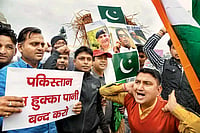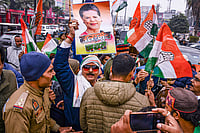Addressing the DGPs’ conference on November 25, Union home minister Rajnath Singh sounded optimistic that the Maoist threat would be eliminated in the next five years. The Maoists, he claimed, were in retreat in almost all the states. No doubt, the security forces have achieved successes against Maoists in the recent past. In the last week of October, they killed 30 Maoists in successive encounters in Orissa’s Malkangiri district—part of the region the Maoists call Andhra-Orissa Border (AOB), which has always been their stronghold. Seized documents reveal the Maoists were concerned about the condition of their movement in AOB and keen to do “something big”.
For Maoists in Chhattisgarh, November turned out to be a bad month, with 12 casualties in just three days. This is important as Bastar has been the heartland of the Maoist movement. Elsewhere, in Jharkhand, six Maoists were killed by the CRPF’s Commando Battalion for Resolute Action (CoBRA) and the Jharkhand Police in Latehar district on November 23.
According to the South Asia Terrorism Portal, at least 775 Maoists have been neutralised (93 killed, 434 arrested and 248 surrendered) betwen 2010 and October 30, 2016. Casualties in Maoist violence declined from a peak of 1,180 in 2010 to 215 in 2015. Demonetisation, too, seems to have upset the Maoists’ financial calculations and could lead to more desertions and surrenders. No wonder the home minister exudes confidence. But it would be naïve to conclude that we are in the process of vanquishing the Maoist movement, which has seen many ups and downs over the past five decades of its existence. Starting from Srikakulam in Andhra Pradesh and Naxalbari in West Bengal in the 1960s, it rose to a crescendo in 1971 when its impact was felt in India’s farthest corners. Then, too, the death of the movement’s ideologue, Charu Majumdar, followed by splits in the organisation, had given an impression that it was as good as over. But, in 1980, the movement got a fresh lease of life with the founding of the CPI-ML (People’s War) in Andhra Pradesh.
With Andhra Pradesh as the epicentre, the MaoIST movement spread to the adjoining states of Maharashtra, Madhya Pradesh and Orissa, besides Bihar, West Bengal, Karnataka and Tamil Nadu. It suffered a setback again with the arrest of its leader, Kondapalli Seetharamaiah, and other successful police operations.
The movement saw its second revival at the turn of the century when it was militarised with the formation of the PLGA (People’s Liberation Guerrilla Army). And four years later, on September 21, 2004, the CPI-ML (People’s War) merged with the Maoist Communist Centre (MCC) to form the CPI (Maoist). The new party emerged as the leading organisation that works for a “new democratic revolution in India as part of the world proletarian revolution”, and the erstwhile UPA government described it as the greatest threat to India’s internal security.
Now, suppose the government is indeed able to blunt the movement’s edge and significantly contain it. Even then it would be simplistic to think the Maoist threat would be eliminated soon because the movement has always resurrected in a new avatar every time it was put down by the security forces. The simple reason is that the socio-economic factors that gave rise to it and sustain it remain largely unaddressed. Poverty continues to be a huge problem. In 2011-12, according to a Planning Commission expert group headed by C. Rangarajan, 29.5 per cent of the population was below the poverty line, while India has the fourth highest number of billionaires in the Forbes 2015 billionaire list (after the US, China and Germany). The net worth of the top 10 per cent of the population, says a World Bank report (2015), is 380 times that of the bottom 10 per cent. Land reform is not on the agenda of any state government and, according to a survey conducted by the Labour Bureau, over a third of the working people are employed for less than 12 months in a year. Corruption at higher levels has been checked somewhat, but continues to be rampant at the lower levels.
The tribals are an unhappy lot. The 11th Five Year Plan admitted that the tribals are alienated because land, forests and common property resources are slipping out of their hands, besides displacement and dispossession of their life-support systems. According to the 2008 report of a Planning Commission expert group on “development challenges in extremist-affected areas”, these areas in central India were “minimally administered” and state interventions, both for development and law and order, had been fairly low. As a result, there is a kind of administrative vacuum that is exploited by the armed insurgent groups. As long as these factors continue, the Maoist movement would continue to haunt the Indian State and pose a formidable problem to the law-enforcement agencies.
(Prakash Singh, a former IPS officer, is author of The Naxalite Movement in India.)


























